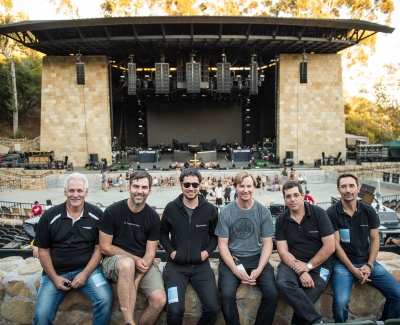
Natural Environment
According to FOH engineer Hutchinson, “Using the L-ISA Processor was a seamless transition from the traditional systems. Once all of the MADI outputs were patched into the processor, mixing became a natural environment in which each channel represented its own space within the mix. Suddenly placement of the instruments became more lifelike resulting in an immersive matrix of sound, which I have never experienced before.
“In addition to the immersive sound, I noticed that all of the instrument nuances finally started to present themselves much clearer than ever before. This, in return, allowed for the entire mix to translate the artists’ emotion while becoming fully immersive and containing tremendous amounts of depth and clarity.”
ODESZA was directly involved with the design of the system and how audio was placed and used for special effects throughout the show, explains Clearwing Productions director of operations Bryan Baumgardner, who adds, “For example, they had a female vocalist join them at one point, and as she walked around the stage, they were tracking her position on the computer and the audio was following her. On another song, they invited Carlos Mosquera to ‘wave’ the audio around the venue with his hand from the house mix position using a motion tracker. The whole audience was able to experience the effect, which was awesome.

“The biggest takeaway I have from this show was the imaging – no matter where you were in the venue, it was absolutely perfect,” he continues. “Nearly every single seat in the Santa Barbara Bowl was able to hear the complete mix with no artifacts, which was completely mind-blowing. Everything was exactly the same everywhere for most of the audience, which is totally unheard of.”
Mixing To Locations
L-ISA, which stands for Immersive Sound Art, utilizes object-based audio, describes Scott Sugden, L-Acoustics head of application, touring. “Mixing with L-ISA tools for an L-ISA frontal configuration frees the engineer from the traditional constraints of stereo or LCR,” he explains. “Each console channel becomes a sound object that can be freely positioned in the soundscape, while the engineer can very accurately localize sources and track performers on stage. The properties of each sound object are defined independently from the loudspeaker layout, so the entire mix can be retained across a wide variety of venues and system configurations.”
On the day prior to the show, while Sugden was helping Baumgardner and the tour’s rigger load the PA into the venue, Mosquera and Hutchinson were in the studio at L-Acoustics with the DiGiCo SD10 console mixing ODESZA’s tracks with the L-ISA Controller and writing all of the snapshots.
Mosquera and Hutchinson created a similar, but not exactly identical, design environment to the Santa Barbara Bowl in which to set up the show’s immersive experience. “The way the L-ISA Controller works, you don’t have to have an exact match to generate mix parameters in advance because we’re not dealing with buses,” Mosquera says. “We’re mixing to locations, not speakers. So this separation means that we can transition from the studio to any show environment and achieve a very similar relationship in the immersive mix, regardless of the venue’s size.”
A key aspect when designing shows at the Santa Barbara Bowl is that there are residences all around the venue, so noise pollution is a concern. “The Bowl is only permitted a certain number of shows each year, and the noise requirements there are quite strict,” Baumgardner notes. “You can’t go past 105 dB for a minute, but thanks to the immersive coverage that L-ISA provided, we were easily able to stay well under that number and yet sound incredibly full. The system had tons of headroom and we barely needed to push it.”
An Extra Dimension
With the Santa Barbara Bowl show being the only stop using the L-ISA system on this tour, the band returned to its original system for the rest of the run. “I caught the show in Madison a couple of weeks later, and it was in a conventional left-right deployment,” Baumgardner says. “It was the same show, and still a terrific performance by the group and sound system, but after being a part of the Bowl show, it clearly didn’t have the same depth and emotion to it.
“Once artists and crowds start becoming more exposed to experiencing concerts in immersive 3D like this, it’s going to be difficult to go back to mono and stereo,” he concludes. “Much like V-DOSC set the standard more than two decades ago for today’s global line array movement, L-ISA’s hyperrealistic soundscape really takes audio reinforcement to the next level and, in my opinion, represents the future of concert sound.”
Editor’s Note: Baumgardner notes that there were many players that were key to making this project come together: ODESZA’s tour crew, including tour manager Bryan Aiello and Ableton tech Winnie Murguia; production director JB Blot and production manager Shane Crowl of Motion Music; Clearwing audio crew chief Matt Fox; FOH system tech Joe Spitzer; monitor system tech Eric Rodgers; director of engineering production Jamie Earle; Clearwing Colorado general manager Johnny Goode and Clearwing president/CEO Gregg Brunclik; and L-Acoustics’ staff.
